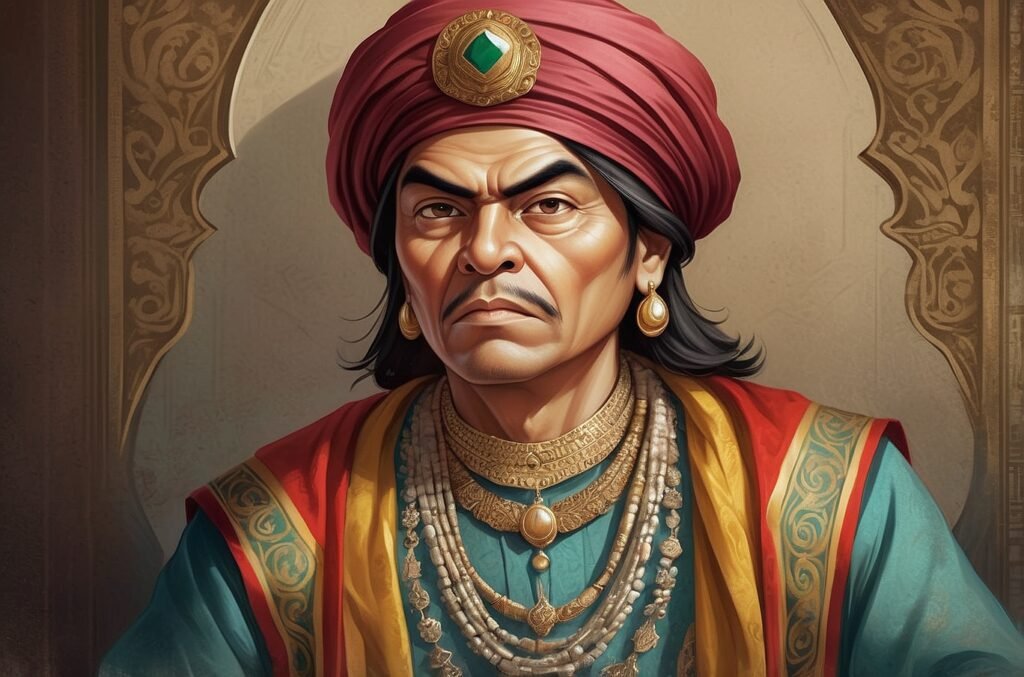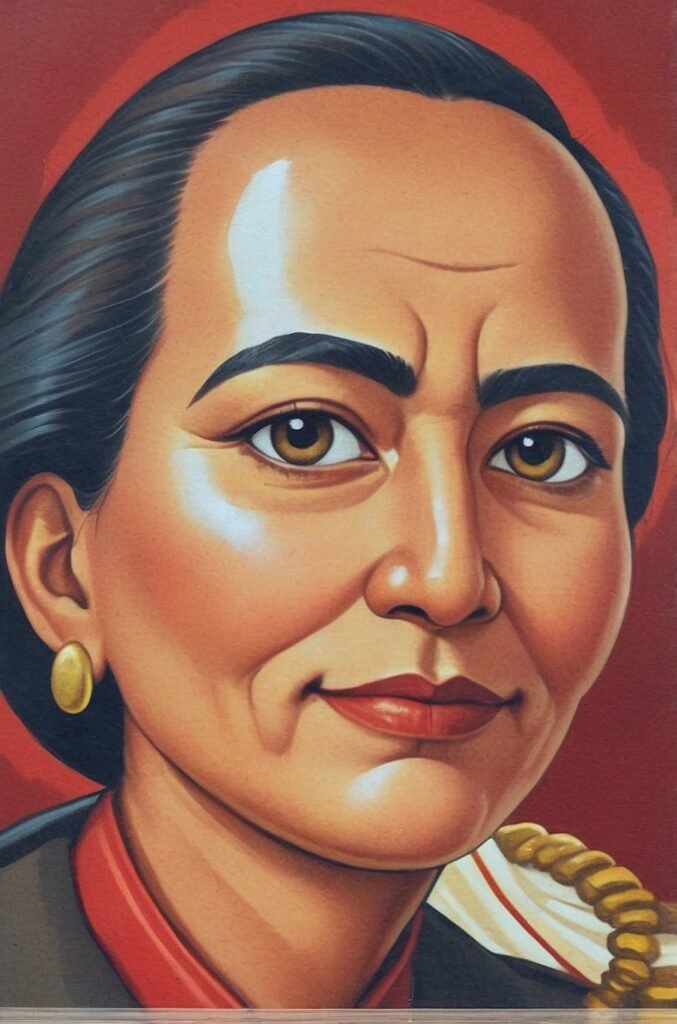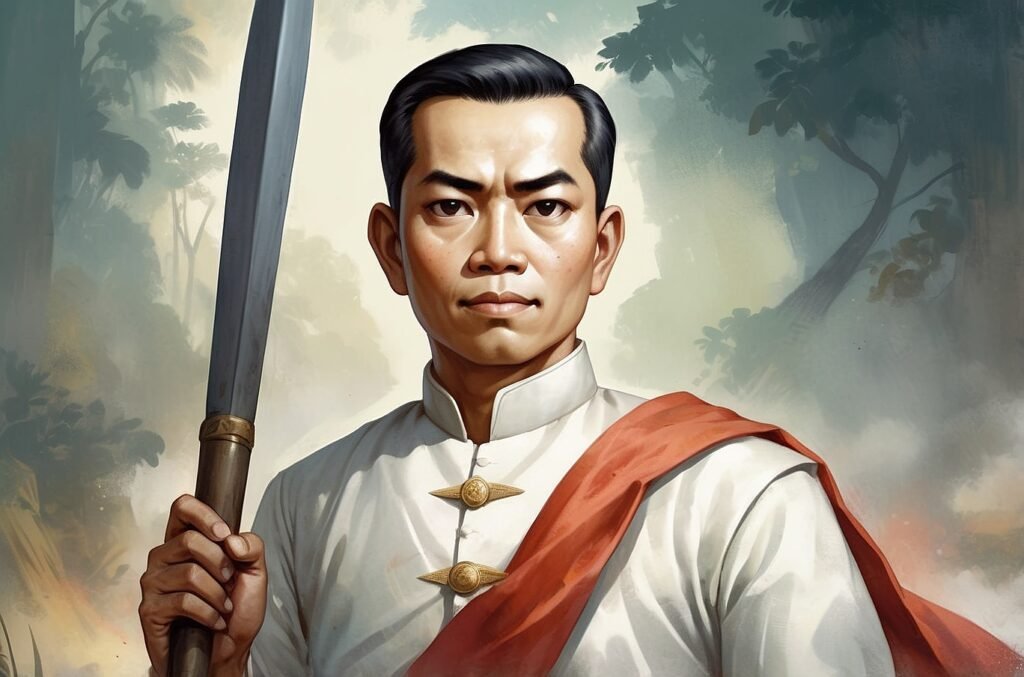Sultan Muhammad Dipatuan Kudarat, more commonly known as Sultan Kudarat, stands as a towering figure in Philippine history. His legacy as a formidable leader who successfully resisted Spanish colonization efforts in Mindanao during the 17th century has earned him a place of honor among the nation’s heroes. This blog post delves into the life, reign, and enduring impact of Sultan Kudarat, exploring how his strategic acumen and unwavering determination shaped the course of Philippine history and preserved the independence of his people for generations.
Early Life and Rise to Power
Birth and Lineage
Sultan Kudarat was born in 1581 in the Sultanate of Maguindanao, located in the southern Philippine island of Mindanao. He was the son of Sultan Buisan and a direct descendant of Sharif Muhammad Kabungsuwan, the founder of the Maguindanao Sultanate. This royal lineage positioned Kudarat as a natural heir to the throne and instilled in him a deep sense of responsibility towards his people and their heritage.
Education and Training
As a young prince, Kudarat received a comprehensive education befitting his royal status. He was trained in the art of governance, diplomacy, and warfare, skills that would prove invaluable in his future role as Sultan. His education also included a strong grounding in Islamic teachings and cultural traditions, which shaped his worldview and informed his leadership style.
Ascension to the Throne
In 1619, at the age of 38, Kudarat ascended to the throne of the Maguindanao Sultanate following the death of his father, Sultan Buisan. His coronation marked the beginning of a reign that would span over five decades and leave an indelible mark on the history of Mindanao and the Philippines as a whole.
The Maguindanao Sultanate Under Sultan Kudarat
Expansion and Consolidation
Upon assuming power, Sultan Kudarat embarked on a campaign to strengthen and expand the Maguindanao Sultanate. He skillfully navigated the complex political landscape of Mindanao, forging alliances with neighboring kingdoms and subjugating rival chieftains. Through a combination of diplomatic finesse and military prowess, Kudarat extended the sultanate’s influence across a vast territory, encompassing much of central and western Mindanao.
Economic Prosperity
Under Sultan Kudarat’s leadership, the Maguindanao Sultanate experienced a period of significant economic growth. The Sultan actively promoted trade with neighboring regions and foreign powers, including China and other Southeast Asian kingdoms. He established Maguindanao as a major trading hub, facilitating the exchange of goods such as spices, textiles, and precious metals.
Table: Key Trade Partners of the Maguindanao Sultanate under Sultan Kudarat
| Trade Partner | Main Exports | Main Imports |
|---|---|---|
| China | Spices, Pearls | Porcelain, Silk |
| Sulu Sultanate | Slaves, Sea Products | Textiles, Weapons |
| Borneo | Forest Products | Rice, Metal Goods |
| Java | Spices | Textiles, Ceramics |
Cultural and Religious Policies
As a devout Muslim ruler, Sultan Kudarat played a crucial role in strengthening Islamic influence in Mindanao. He encouraged the spread of Islam throughout his domains, patronizing Islamic scholars and supporting the construction of mosques and madrasas. However, Kudarat also demonstrated a degree of religious tolerance, allowing non-Muslim communities within his realm to practice their faiths, provided they acknowledged his sovereignty.
Resistance Against Spanish Colonization
The Spanish Threat
By the time Sultan Kudarat assumed power, the Spanish colonial forces had already established a strong presence in the northern and central Philippines. The conquistadors, driven by a desire for territorial expansion and the spread of Christianity, set their sights on Mindanao as their next conquest. This impending threat posed a significant challenge to the sovereignty of the Maguindanao Sultanate and other Muslim polities in the region.
Early Encounters and Victories
Sultan Kudarat’s first major confrontation with the Spanish forces occurred in 1625 when a Spanish expedition led by Captain Ginés Ros attempted to establish a foothold in Maguindanao territory. Kudarat, employing superior knowledge of the terrain and guerrilla tactics, successfully repelled this invasion, dealing a significant blow to Spanish ambitions in the region.
The Battle of Buayan (1637)
One of the most pivotal moments in Sultan Kudarat’s resistance against Spanish colonization came in 1637 during the Battle of Buayan. Governor-General Sebastián Hurtado de Corcuera personally led a large Spanish force into Maguindanao territory, intent on subduing the sultanate once and for all. Sultan Kudarat, demonstrating his tactical genius, lured the Spanish forces into unfavorable terrain and launched a series of devastating counterattacks.
The battle resulted in a decisive victory for Sultan Kudarat, with the Spanish forces suffering heavy losses and being forced to retreat. This triumph not only secured the independence of the Maguindanao Sultanate but also dealt a severe blow to Spanish prestige in the region.
Diplomatic Maneuvering
While Sultan Kudarat was a formidable military leader, he also understood the importance of diplomacy in maintaining his realm’s independence. He skillfully played different colonial powers against each other, forming temporary alliances when necessary to prevent any single foreign power from gaining too much influence in Mindanao.
For instance, Kudarat maintained cordial relations with the Dutch, who were rivals of the Spanish in the region. This strategic relationship provided the sultanate with access to modern weapons and served as a counterbalance to Spanish power.
Legacy and Impact
Preservation of Independence
Sultan Kudarat’s most significant achievement was his success in preserving the independence of the Maguindanao Sultanate and large parts of Mindanao from Spanish colonization. His resistance effectively created a buffer zone that prevented the complete subjugation of the Philippine archipelago by colonial powers. This allowed the Muslim communities of Mindanao to maintain their cultural, religious, and political identity for centuries.
Inspiration for Future Resistance
The example set by Sultan Kudarat inspired subsequent generations of Muslim leaders in Mindanao to continue resisting foreign domination. His legacy of defiance against colonial powers became a rallying point for Moro (Philippine Muslim) identity and aspirations for self-determination, influences that can still be felt in contemporary Philippine politics.
Cultural Icon
Sultan Kudarat has been immortalized in Philippine culture as a symbol of resistance and leadership. His name has been given to a province in Mindanao, and his image has appeared on Philippine currency. Numerous schools, streets, and public buildings across the country bear his name, ensuring that his legacy continues to be remembered and celebrated.
Graph: Timeline of Major Events in Sultan Kudarat’s Reign
Year | Event
-----+------------------------------------------------------
1581 | Birth of Sultan Kudarat
1619 | Ascension to the throne of Maguindanao Sultanate
1625 | Repels first major Spanish invasion attempt
1637 | Victorious in the Battle of Buayan against Spanish forces
1645 | Expands Sultanate's influence to peak territorial extent
1671 | Death of Sultan KudaratAnalysis of Sultan Kudarat’s Leadership Style
Strategic Acumen
Sultan Kudarat’s success in resisting Spanish colonization can be attributed in large part to his exceptional strategic thinking. He demonstrated an ability to analyze complex geopolitical situations and make decisions that maximized his realm’s chances of survival and prosperity. His use of guerrilla warfare tactics, exploitation of terrain advantages, and clever diplomatic maneuvering all showcase a leader with a keen understanding of both military and political strategy.
Adaptive Leadership
One of the key characteristics of Sultan Kudarat’s leadership was his adaptability. He recognized the need to modernize his forces to compete with European weaponry, actively seeking out alliances that could provide access to advanced military technology. This willingness to adapt and innovate allowed the Maguindanao Sultanate to remain competitive against technologically superior adversaries.
Charisma and Unifying Influence
Sultan Kudarat possessed a charismatic personality that allowed him to unite diverse groups under his banner. He successfully brought together various Muslim and non-Muslim communities within his realm, creating a cohesive force capable of standing against external threats. His leadership inspired loyalty and courage among his followers, crucial factors in the sultanate’s ability to resist Spanish incursions.
Long-term Vision
Unlike many leaders who focus solely on immediate threats, Sultan Kudarat demonstrated a remarkable ability to plan for the long-term survival and prosperity of his people. His efforts to strengthen the economic, cultural, and military foundations of the Maguindanao Sultanate ensured that it would remain a formidable power in the region long after his reign.
Comparative Analysis: Sultan Kudarat and Other Anti-Colonial Leaders
To better understand Sultan Kudarat’s place in history, it is instructive to compare him with other notable leaders who resisted colonial expansion during the same era.
Comparative Analysis of Anti-Colonial Leaders
| Leader | Region | Period | Colonial Power Resisted | Outcome |
|---|---|---|---|---|
| Sultan Kudarat | Mindanao, Philippines | 1619-1671 | Spain | Successful resistance, maintained independence |
| Hang Tuah | Malacca | 15th century | Portugal | Initial resistance, ultimately defeated |
| Nzinga of Ndongo and Matamba | Angola | 17th century | Portugal | Prolonged resistance, partial success |
| King Naresuan | Siam (Thailand) | Late 16th century | Burma | Successful resistance, maintained independence |
This comparison highlights the exceptional nature of Sultan Kudarat’s achievements. While many anti-colonial leaders ultimately saw their domains fall to European powers, Kudarat succeeded in maintaining the independence of his realm throughout his lifetime and beyond.
The Lasting Impact of Sultan Kudarat’s Resistance
Shaping Philippine National Identity
Sultan Kudarat’s successful resistance against Spanish colonization has played a significant role in shaping Philippine national identity. His story serves as a powerful reminder of the country’s diverse cultural heritage and the long history of struggle against foreign domination. For many Filipinos, particularly those from Mindanao, Kudarat represents a source of pride and a symbol of resilience in the face of overwhelming odds.
Influence on Modern Moro Movements
The legacy of Sultan Kudarat continues to resonate in contemporary Philippine politics, particularly in the context of Moro autonomy movements. Many modern Moro leaders draw inspiration from Kudarat’s example, citing his successful defense of Muslim sovereignty as a historical precedent for their own aspirations for self-determination.
Historical Lessons in Resistance and Diplomacy
The strategies employed by Sultan Kudarat in resisting Spanish colonization offer valuable historical lessons in the art of asymmetric warfare and diplomatic maneuvering. His ability to leverage local knowledge, form strategic alliances, and adapt to changing circumstances provides a compelling case study for understanding successful resistance against technologically superior adversaries.
Conclusion
Sultan Muhammad Dipatuan Kudarat’s reign marks a crucial chapter in Philippine history, representing a period of successful resistance against Spanish colonial ambitions. Through his strategic brilliance, diplomatic acumen, and unwavering determination, Kudarat not only preserved the independence of the Maguindanao Sultanate but also played a pivotal role in shaping the cultural and political landscape of Mindanao and the Philippines as a whole.
The legacy of Sultan Kudarat extends far beyond his lifetime, continuing to influence discussions on cultural identity, religious tolerance, and political autonomy in the modern Philippines. As a symbol of resistance and effective leadership, Sultan Kudarat remains a revered figure, his story serving as an enduring source of inspiration for generations of Filipinos.
In an era where global powers sought to reshape the world according to their own designs, Sultan Kudarat stood as a testament to the power of local resistance and the importance of preserving cultural heritage. His life and achievements remind us of the complex tapestry of Philippine history and the enduring spirit of a people determined to chart their own course in the face of overwhelming odds.
Disclaimer: While every effort has been made to ensure the accuracy of the information presented in this blog post, historical accounts may vary, and new research may shed additional light on certain aspects of Sultan Kudarat’s life and reign. Readers are encouraged to consult multiple sources and engage in further research to gain a comprehensive understanding of this important historical figure. If you notice any inaccuracies in this post, please report them so we can promptly make corrections.




